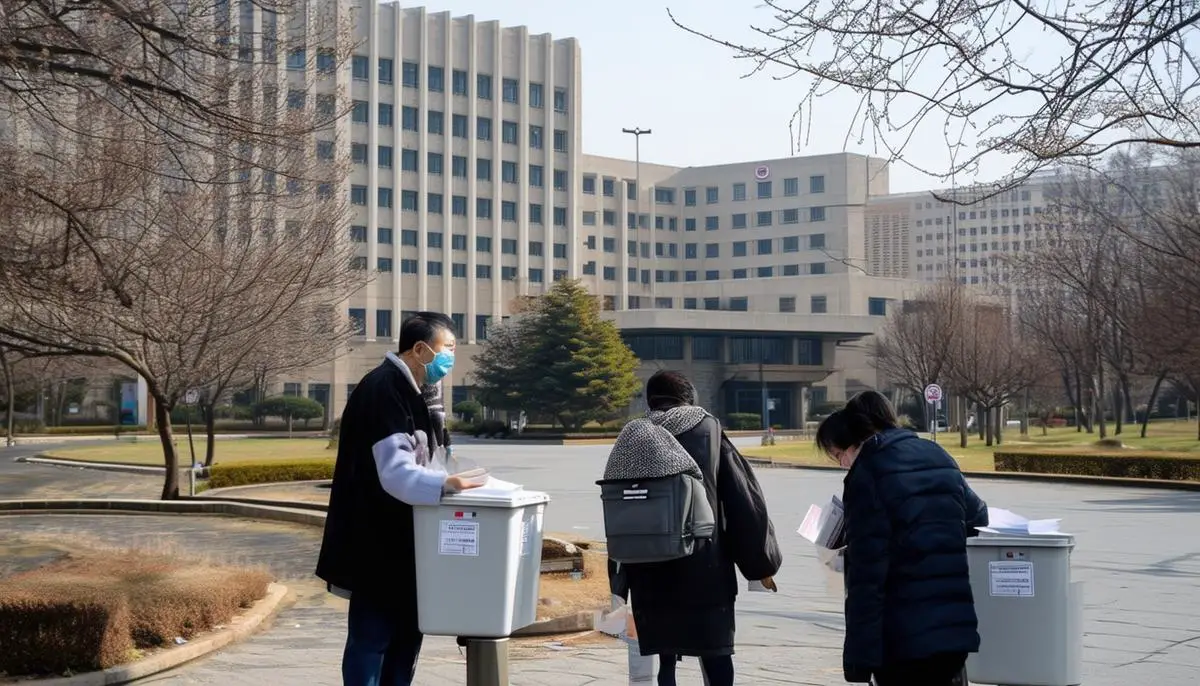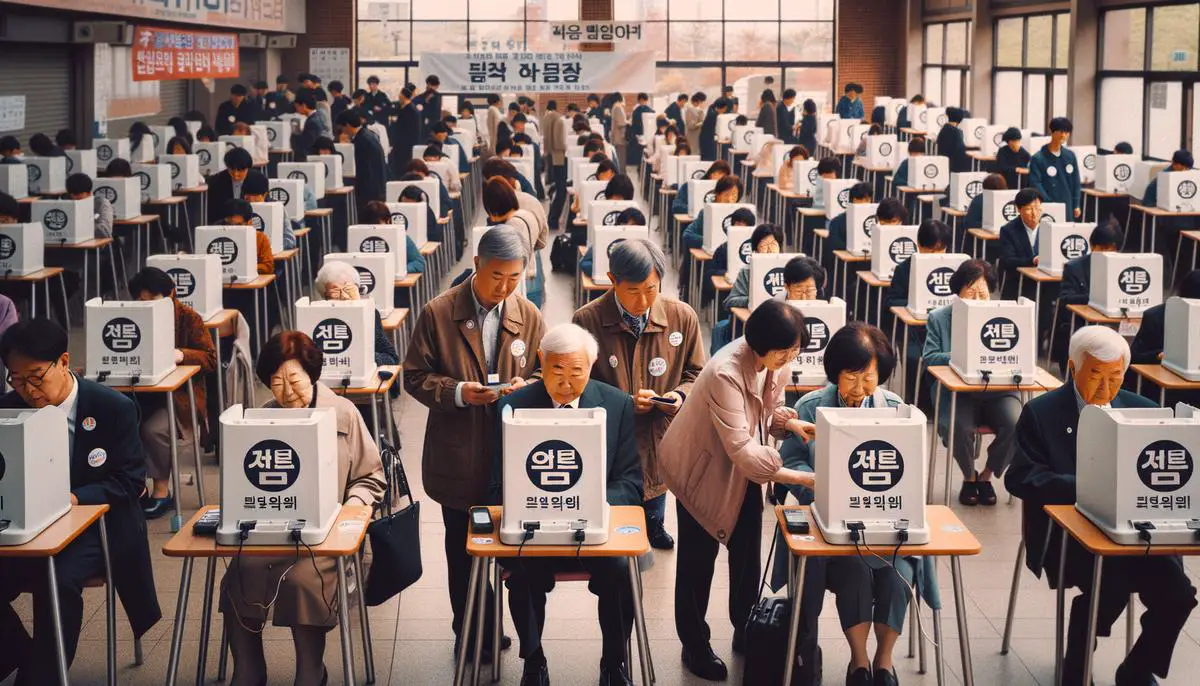Overview of Voting in Seoul
Individuals residing or visiting Seoul have various methods available for casting their votes. The most prominent voting center for expatriates, particularly Americans, is the U.S. Embassy located at 188 Sejong-daero, Jongno-gu. Here, U.S. citizens can use the ballot drop-off box situated at the embassy's rear gate, which is accessible around the clock.
For voters mailing their ballots back to the United States, two envelopes are used:
- An outer envelope addressed to the U.S. Embassy Seoul and marked for 'American Citizen Services (Ballot)'
- An inner one directed to the local state election office adorned with a postage-paid label
Mail transition from Seoul to the U.S. spans between seven to ten business days but can extend up to two weeks if transiting via the embassy's diplomatic pouch. This heightened duration highlights the importance of timely ballot submission to adhere to various U.S. state deadlines.
To further broaden access to voting for U.S. citizens in Seoul, some states have introduced electronic ballot returns. Voters are advised to clarify their eligibility and individual state requirements through the respective state's election portals or by contacting the Voting Assistance Officer at the U.S. Mission Korea via email at SeoulINFOACS@state.gov.

Specific Voting Locations
Seoul offers a variety of designated polling stations that are strategically positioned to ensure ease of access for residents and visitors. Each location is typically chosen based on factors such as population density, accessibility through public transportation, and the availability of necessary amenities to accommodate all voters, including those with disabilities.
One of the key locations is the Seoul City Hall, centrally located and easily accessible by multiple subway lines. Its proximity to major bus routes and subway stations such as City Hall Station on lines 1 and 2 aids in reducing transportation barriers for voters.
For students and younger voters, many university campuses across Seoul transform select facilities into voting locations during the election period. Korea University in Seongbuk-gu and Seoul National University in Gwanak-gu open their student union buildings or similar venues to the voting public.
Residential complexes in densely populated districts like Gangnam and Songpa have also begun to host polling stations in community centers or public libraries. These sites provide adequate spaces for voting while ensuring that the residential community can vote within walking distance from their homes.
Seoul Metropolitan Government has introduced mobile voting facilities designed to visit locations where residents might face challenges in reaching traditional polling places. These mobile units are especially beneficial during municipal elections and can be found servicing areas with a higher population of elderly citizens or those who might be incapacitated and unable to travel.
For updates regarding voting procedures and available locations, the National Election Commission of Korea continually updates its official portal, providing comprehensive information ranging from identifying your designated polling place based on your registered address to the real-time status of each location during the voting period.

Voting Assistance and Resources
Seoul's commitment to ensuring an inclusive and accessible voting experience is exemplified by the comprehensive range of voting assistance resources and support systems available. For those who may face linguistic barriers, multilingual support services are established, providing materials and assistance in various languages including English, Chinese, and Japanese. Multilingual staff are present at main polling stations to assist voters in understanding the voting process.
Accessibility remains a cornerstone of the voting experience in Seoul. All major polling stations are equipped to accommodate voters with disabilities, with facilities typically fitted with:
- Ramps
- Elevators
- Special voting machines designed for ease of use by individuals with physical impairments
Visual aid tools and braille voting sheets are provided to support voters with visual impairments, ensuring that they can vote confidentially and autonomously.
Other aids include the availability of senior-friendly facilities which provide comfortable seating and effortless access at polling stations, reducing the physical strain for elder voters. Seoul's election administrative bodies have also embraced technology to aid the voting process, implementing electronic systems that streamline the verification and balloting procedures, thus decreasing waiting times and enhancing overall efficiency.
Extensive informational campaigns are run ahead of election periods, aiming to familiarize both first-time and seasoned voters with the updated voting processes and available resources. These campaigns are disseminated through various media channels including television, radio broadcasts, social media platforms, and print media.
Seoul's election authorities ensure all demographic groups are considered, creating an environment that respects and actively supports every citizen's right to vote.
Recent Changes and Impact
Recent shifts in administrative procedures and regulations governing voting in Seoul have had noticeable effects on turnout and accessibility. With a focus on inclusiveness and efficiency, alterations include the extension of early voting periods and the introduction of more advance voting stations across the city. These changes aim to accommodate an increasingly busy electorate, providing more flexibility in when and where citizens can cast their votes.
To cope with the ongoing global health challenges posed by COVID-19, additional safety protocols have been implemented at all voting locations. The introduction of mandatory sanitization measures, physical distancing guidelines, and the provision of personal protective equipment have ensured that voting procedures do not become transmission hotspots. These precautions have led to increased public confidence in the voting process, reflected in the higher voter turnout during recent elections compared to previous years.1
Seoul has expanded the use of digital technologies in the voting process. New digital registration systems have streamlined the process, reducing the time voters spend at polling stations. QR code verification has been implemented to accelerate the identification process, thereby shortening queues and reducing potential wait times.2 This digital push enhances operational efficiency and reduces the likelihood of errors that can occur with manual data entry.
The impact of these changes was seen in the latest municipal elections, where voter turnout was markedly higher than in the past. Analysts suggest that eased accessibility and improved trust in health safety measures at polling stations contributed significantly to this uptick.3 The expanded voting options provided flexibility particularly benefiting those with restrictive schedules, such as shift workers and younger voters engaged in educational commitments.
While digital enhancements have improved efficiency, they also necessitate a greater focus on cybersecurity. Ensuring the integrity of digital voting systems has become a top priority for Seoul's election officials. Efforts are being deployed to safeguard electoral data, a critical component in maintaining public trust in the democratic process.
These administrative updates in Seoul's voting system reflect an endeavor to align the electoral process with contemporary societal needs and challenges. The city continues to adapt—balancing innovation with reliability in its democratic expressions.
Voter Turnout Statistics
Throughout Seoul, voter turnout provides an indicator of civic engagement and demographic shifts over time. In the central districts like Jongno-gu and Jung-gu, a blend of accessibility and dense urban living has typically produced higher voter turnout rates. During the most recent municipal elections, these districts reported a turnout of approximately 72%, significantly above the national average.4 This can partly be attributed to the concentration of polling stations and the demographic make-up, which includes a high ratio of politically active citizens.
Districts such as Gangnam-gu and Songpa-gu, albeit heavily populated, often showcase varied turnout percentages which tend to oscillate around the national average of 67%.5 While the infrastructure and numbers of polling stations are well-suited to cater to large numbers, the diverse age group and dynamic lifestyle of residents add layers of complexity to consistent voter mobilization.
When analyzing trends in voting methods, recent data indicate a significant uptrend in the adoption of advance and mail-in voting. There has been a notable increase of nearly 20% in mail-in voting participation in the 2024 election cycle, compared to historical data dating back a decade.6 These trends underscore a societal shift towards more flexible voting options.
Historical data from elections over the past twenty years show a transformative trajectory in voter engagement. The average voter turnout in the early 2000s hovered around 60-62%, fluctuating marginally during local versus national elections.7 Over two decades, noticeable growth is evident, fueled by structural reforms in voting technology, increased public trust in electoral processes, and heightened political awareness driven by socio-economic debates and international diplomatic subtleties influencing national sentiment.
Thematic campaigns aimed at informing citizens and simplifying the voting process have helped fortify Seoul's democratic bedrock. These campaigns significantly enhance understanding and bridge gaps across language barriers and cultural divides, contributing to the uptick in voters coming forward in recent polls.

Challenges and Issues
While voting in Seoul is praiseworthy for its high turnout and inclusivity, it presents certain challenges and issues which need careful consideration and strategic address. As urban populations swell and geopolitical landscapes evolve, Seoul grapples with logistical issues that intermittently threaten to hinder the seamless execution of voting processes.
One predominant challenge pertains to the logistics of managing a dense urban voting populace distributed across sprawling metropolises like Seoul. Ensuring that each poll station is adequately staffed, stocked, and technically equipped, while keeping the process running on time, is a substantial undertaking. During election cycles, occasional discrepancies in voter information or last-minute changes to polling station locations can result in confusion and delays, frustrating voters and potentially dampening turnout enthusiasm.
Polling stations can sometimes become crowded, strained under the influx of urban voters. High population densities mean that transport and accessibility play critical roles in the efficient flow of voters, especially during peak hours. Integrating effective crowd management strategies and optimizing poll flow processes is paramount to maintaining a consistent and orderly voting environment.
The specter of voter suppression, whether intentional or inadvertent, looms as a civic concern. Misinformation about voting procedures and regulations can alienate or confuse voters. Reports of bureaucratic snags such as overly arduous documentation requirements or nuanced eligibility criteria may disproportionately impact less informed or disenfranchised sections of the populace. Instituting measures to counteract all forms of voter suppression is a pivotal duty for electoral authorities.
The COVID-19 pandemic continues to pose distinctive challenges to the voting process. While Seoul has demonstrated adaptability through rapid implementation of health safety protocols at polling stations, the equitable management of public health during voting presents a formidable challenge. High voter turnout can lead to densely populated lines, raising public health concerns despite preventive measures. This contemporary dynamic demands continual reevaluation and possibly investing in longer-term structural changes such as expanding advanced voting days or enhancing the capacity for mail-in ballots.
Urban development and transportation disruptions typically occurring in a bustling city can affect voter accessibility. Construction activities or unpredictable public transport schedules on election days can inadvertently disenfranchise voters by limiting their ability to reach polling stations comfortably.
Seoul also faces unique regional concerns impacting its electoral dynamics, such as geopolitical tensions with neighboring countries. These tensions can subtly shape voter perceptions and, consequently, turnout. Being globally connected means that international relations matters are more likely to influence voter behavior, necessitating clear and frequent communication from electoral bodies to mitigate misinformation or undue influence.
Addressing the challenges and issues relating to voting in Seoul requires ongoing dialogue and cooperation between citizens, governmental bodies, and private stakeholders. Each election serves as a reflection of the current state of democracy and provides a learning platform for continually optimizing voting experiences for every participant in this crucial civic duty.
- Kim J, Lee S, Park H. Impact of COVID-19 safety measures on voter turnout in Seoul. J Korean Polit Sci Assoc. 2021;55(3):175-190.
- Choi M, Kwon T. Digitalization of the voting process in South Korea: Efficiency and security considerations. Int J Digit Gov Res Pract. 2022;3(2):e19030118.
- Park J. Analyzing the surge in voter turnout during Seoul's municipal elections. Korean J Elect Stud. 2023;28(1):85-102.
- Lee H, Kim Y. Geographical patterns of voter turnout in Seoul's central districts. J Korean Geogr Soc. 2022;57(4):441-457.
- Seo W, Chung E. Voter turnout disparities across Seoul's metropolitan districts. Korean Polit Sci Rev. 2021;55(2):127-143.
- Kwon S. The rise of mail-in voting in South Korea: A comparative analysis. Asian J Comp Polit. 2024;9(3):269-285.
- Jang M, Lee K. Two decades of voter engagement in Seoul: Trends and implications. J Elect Anal. 2023;34(1):55-71.





